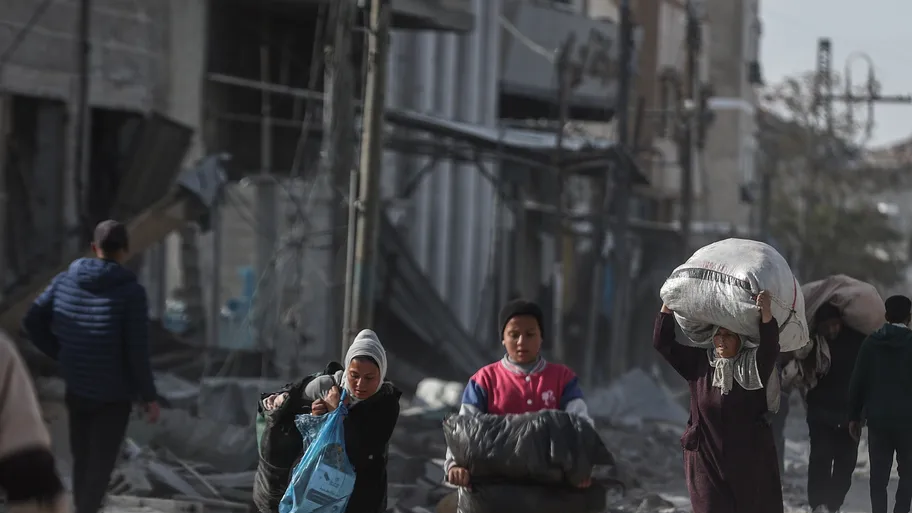 Displaced Palestinians start to return their houses after the announcement of ceasefire in Gaza Sunday. Photo: Ali Jadallah/Anadolu via Getty Images
Displaced Palestinians start to return their houses after the announcement of ceasefire in Gaza Sunday. Photo: Ali Jadallah/Anadolu via Getty Images
After a three hour delay, the ceasefire in Gaza began at 11:15 a.m. local time (4:15 a.m. ET) with Israel and Hamas agreeing to stop the fighting for 42 days.
Why it matters: This is the first ceasefire in the Gaza war since November 2023, when the first hostage deal led to an 8-day pause in the fighting.
- The war, which started with the Hamas terror attack against Israel on October 7, 2023, has been the bloodiest period in the Israel-Palestinian conflict since 1948.
- More than 46,000 Palestinians and more than 1,600 Israelis have been killed — most of them civilians.
- The war created a devastating humanitarian crisis in Gaza, displacing around two million Palestinians and destroying tens of thousands of buildings — making the Gaza strip close to uninhabitable.
Driving the news: The ceasefire was supposed to begin at 8:30 a.m. local time (1:30 a.m. ET) on Sunday.
- But after Hamas failed to submit a list of the three hostages it is going to release on Sunday, Israel announced the ceasefire will not come into force.
- Hamas claimed the delay was due to technical reasons, mainly the security situation on the ground.
- Israeli jets conducted several air strikes in Gaza on Sunday morning local time with at least 8 Palestinians killed.
- Hamas finally submitted the list around 10:30 a.m. local time, and the ceasefire began 45 minutes later.
Catch up quick: The ceasefire deal was signed in Doha earlier this week after months of indirect negotiations between Israel and Hamas with Qatari, Egyptian and U.S. mediation.
- The deal also includes the release of 33 Israeli hostages held by Hamas and the release of 1,900 Palestinian prisoners and detainees, including about 275 prisoners who have been convicted of murdering Israelis.
- The hostage and prisoners release is expected to begin on Sunday 4 p.m. local time (9 a.m. ET). Three Israeli women and 90 Palestinian women and teenagers are supposed to be released.
The latest: On Saturday, ahead of the ceasefire, the Israeli Defense Forces started redeploying some forces in Gaza — moving them outside of the enclave or east towards the buffer zone on the Gaza-Israel border.
- On Sunday morning, even before the ceasefire started, Palestinian civilians started moving back to northern Gaza and to the city of Rafah in the southern tip of the enclave.
- Hamas armed militants and Hamas police started moving into to the streets after months of going underground in fear of Israeli strikes.
The big picture: The conflict in Gaza spread into a regional war engulfing Lebanon, Syria, Yemen, Iraq, the West Bank and Yemen. But fighting has stopped or appears to be stopping soon on each front.
- The ceasefire agreement in Lebanon, signed last November, isolated Hamas and was one of the factors that pushed the group to agree to the hostage deal in Gaza.
- The Israeli strike on Iran in late October deterred the Iranians from further retaliating and led the Shia militias in Iraq to stop their attacks on Israel.
- The collapse of the Assad regime in Syria led to the departure of Iranian forces from the country and closed that front.
- The last active front in the war, which is in Yemen, is also about to close as the Houthi rebels announced they will suspend their attack against Israel as a result of the Gaza ceasefire.
Zoom in: According to the agreement, 33 hostages will be released in the first phase of the deal, including women, children, men over the age of 50 and men under the age of 50 who are wounded or sick. Israel’s assessment is that most of those 33 hostages are alive.
- The hostages will be released gradually throughout the first phase of the agreement, beginning on the first day of the six-week ceasefire in Gaza.
During the first phase, Israeli Defense Forces will also gradually withdraw to a buffer zone in Gaza, near the border with Israel. The IDF will leave the Netzarim corridor in the center of the Gaza Strip and most of the Philadelphi corridor on the border between Gaza and Egypt.
- Palestinians will also be allowed to return to northern Gaza. Those who walk won’t go through security checks but vehicles will be checked by Qatari and Egyptian officials to ensure no heavy weapons are transferred to Gaza.
More than 700 Palestinian prisoners will also be released, including about 275 who are accused of murdering Israelis and are serving life sentences. More than 1,000 other Palestinians from Gaza who were detained by the IDF during the war but didn’t participate in the Oct. 7 attack will also be released.
- Starting today, the first day of the ceasefire, 600 aid trucks, including 50 fuel trucks, will enter Gaza every day. In addition, 200,000 tents and 60,000 mobile homes will be delivered for displaced Palestinians in Gaza.
- The agreement stipulates that Qatar, Egypt and the U.S. will serve as guarantors for the implementation of the agreement.
On the 16th day of the ceasefire, Israel and Hamas will begin negotiations on the second phase of the agreement, which is supposed to include the release of the remaining hostages, a permanent ceasefire and complete Israeli withdrawal from Gaza.




